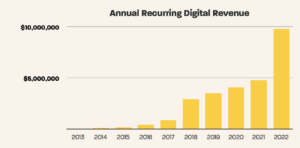Fundraising
Bank Crises and the Future of Nonprofit Fundraising: 3 Strategies for Navigating Economic Uncertainty
It’s become clear: The uncertain economic landscape that nonprofit organizations have been operating within since the start of the pandemic, with results fluctuating between high highs and low lows, is not going away anytime soon.
While we’re consistently amazed by our partners’ donors’ capacity for generosity, it would be disingenuous to claim that economic uncertainty has no impact on giving. The recent news from the banks and the stock market will impact the thinking and planning of your donors, so it’s important for nonprofit leaders to be paying attention and planning ahead, too.
For those facing budget challenges in uncertain times, knowing where not to make cuts is key:
- Resist the temptation to cut your investment in acquiring new donors. Back in 2008, we saw the recession lead many organizations to make cuts to their acquisition investments to free up immediate funds – but now we know that, ultimately, organizations that made those sorts of cuts struggled more in the aftermath.
- Acquire more efficiently, sure, and trim production costs wherever you can, but keep investing in that new donor growth your mission will need in years to come.
- Don’t pull back on donor experience. As supporters become more choosy about where to donate in leaner times, it’s more important than ever that the value and impact their gifts are making be communicated clearly and that they are feeling the love from your org.
We hope that times like this present an opportunity to lean on your agency partners, who are here to help, and who have the capacity and urgency you need to press forward in difficult times.
Today’s economic landscape requires nonprofit fundraisers to be thinking more strategically than ever, to funnel the generosity of our donors that we know persists in the right direction in order to future-proof your fundraising strategy.
In the three strategies below, we’re outlining ways to move away from these kinds of short-term wins toward a more sustainable approach. The best time to prepare for today’s uncertain landscape was years ago, yes – but the right strategic shifts today can shore up your organization’s growth for the future:
Three Strategies to Future-Proof Your Fundraising
1. Grow your sustainer program.
Organizations who have already invested heavily in growing their sustainer program will have more resilience in the tumult of economic uncertainty – it is your committed, monthly donors who you can lean on to provide consistent support.
For one organization we partner with, a concentrated effort on messages promoting sustaining gifts led to a massive increase in in annual recurring digital revenue in just one year:

For another organization we partner with, Save the Children, growing their sustainers became a top priority in response to the influx of new donors they saw responding to their rapid response messaging following the start of the attacks in Ukraine – we discussed their approach to targeting sustaining gifts in a Q&A in June: From Emergency Donor to Sustainer.
2. Build affinity with your audience, to strengthen your connection with the community that’s behind you.
Periods of economic uncertainty have shown us, time and again, the importance of authenticity and transparency. These are the times to lean in and show your audience how relevant your work is at this moment. It may be tempting to ramp up volume and intensity, but know that urgent appeal after urgent appeal will wear on your audience over time. Impact reports and engagement messages during periods when your low-dollar donors may not be able to make a donation will help keep your program’s mission top-of-mind in better times. We’ve found that custom donor journeys (like the ones our partners can utilize with our proprietary Sign For Good tool) offer supporters an interactive experience while still outperforming traditional appeals.
3. Lean on data to invest in smart marketing.
When an uncertain economic climate puts a strain on your fundraising, and cuts need to be made, we can’t emphasize enough how important it is to resist falling into the trap of cutting your email and direct mail acquisition. We encourage our partners to get even smarter with their acquisition plan, using data and modeling to find and target the donors most likely to give.
At MissionWired, a data-centric approach is central to every facet of our work to support nonprofits, and we built The Digital Co-Op to offer organizations with the best tools to get smarter with targeting: through Reactivation, you can identify lapsed donors within your own list who are most likely to re-engage with your mission. With AdvantageAI, the new prospects you acquire for list-growth are modeled to match you with donors proven to respond to organizations similar to yours. And our Facebook Custom Audiences tool offers models to more effectively identify supporters who are most likely to respond to you via paid social advertising.
One nonprofit has been investing in The Digital Co-Op since 2020, making them one of our oldest members. They’ve seen their total investment of $2 million across our various, custom models return more than $4.6 million over the lifetime of their membership.
Every data modeling product in our suite was built to solve a challenge and to help our partners grow, so custom modeling is a critical part of our work – and there’s plenty we can do to help your program discover new, efficient ways to find your best audience. Reach out to get the conversation started: [email protected].
Undoubtedly, times are tough for nonprofit fundraisers as news from the banks and the stock market adds tumult to an already uncertain economic landscape. That’s why we can’t stress enough the importance of leaning on your agency partners through these periods. Our team is here to support and answer any questions – we hope you’ll reach out to us at [email protected] to get the conversation started.
Next insight

